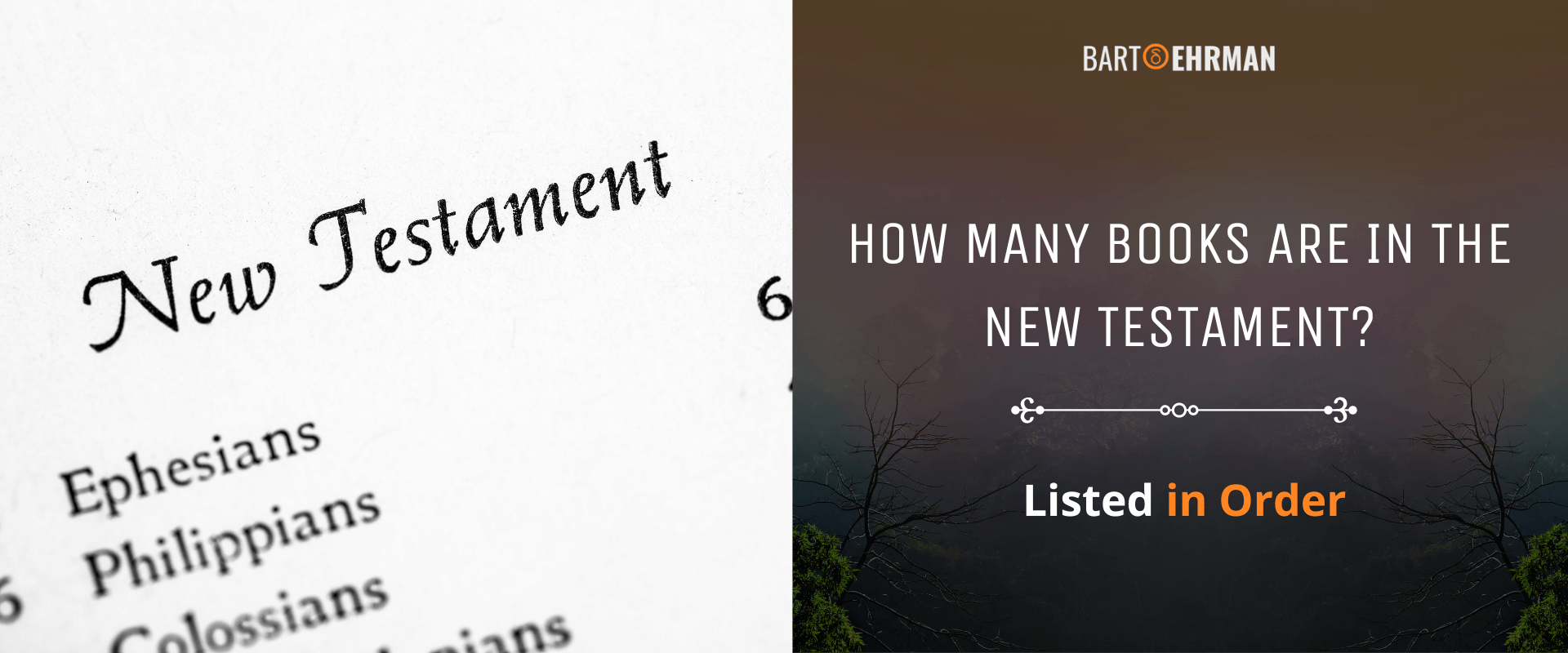How Many Books are in the New Testament? (Listed in Order)

Written by Joshua Schachterle, Ph.D
Author | Professor | Scholar
Author | Professor | BE Contributor
Verified! See our editorial guidelines
Verified! See our guidelines
Date written: April 5th, 2024
Disclaimer: The views and opinions expressed in this article belong to the author and do not necessarily match my own. - Dr. Bart D. Ehrman
Have you ever wondered how many books are in the New Testament? With so many texts and authors included, it can be hard to keep track. And yet all the books in the New Testament provide a fascinating window into the thinking of various early Christian authors and communities.
In this article, I’ll give you the names of all twenty-seven books in the New Testament in the order they appear in the Bible. I’ll also provide a brief breakdown of each book, including authorship, dates of composition, and the general topics they address. Let’s delve into this intriguing library of Christian origins!

Scholars break the twenty-seven books of the New Testament into six categories as you can see in the following chart. Read over the list of New Testament books, then we’ll look more closely at the individual books.
The 27 Books of the New Testament
Category | Books |
|---|---|
The 4 Gospels | Matthew |
The Acts of the Apostles | The Acts of the Apostles |
*13 Pauline Epistles | Romans |
The Epistle to the Hebrews | The Epistle to the Hebrews |
7 General Epistles | James |
The Book of Revelation | The Book of Revelation |
*Note that while these books are collectively known traditionally as the Pauline epistles, scholars debate the authorship of 6 of the 13. Learn more about which books Paul actually wrote in this article.
The Gospels: How Many Books are in the New Testament Gospels?
There are four canonical Gospels in the New Testament, each of which writes the story of the life, death, and resurrection of Jesus of Nazareth. Since some of the Gospels share sources, there is a large amount of overlap between their narratives. There are, however, many differences as well.
By the way, all four Gospels were originally written anonymously. The authorial names ascribed to them came much later in the 2nd century CE.
Matthew: Written around 80-85 CE by a Jewish author - Walter Wilson notes that the author clearly has knowledge of Hebrew – for an audience of primarily Jewish Christians. The author used Mark as a primary source but also includes material not present in Mark, taken from what scholars call the Q source. There is a focus on Jesus’ interpretations of the Jewish Law or Torah.
Mark: This is the earliest of our written Gospels, written around 70 CE. Mark has the lowest Christology – beliefs about the nature and role of Christ – of all four Gospels. Since Jesus’ identity as the Son of God is only revealed to Jesus at his baptism (Mark 1:9-11), the author seems to believe that Jesus was chosen and identified as the Messiah at his baptism rather than at birth.
Luke: Written by a Gentile Christian between 85-95 CE. One of Luke’s main concerns is caring for the poor. This is evident in Jesus’ injunctions to sell one’s possessions and given the money to the poor (Luke 12:33) and especially in his condemnation of the wealthy (Luke 16:19-31).
John: The last of the canonical Gospels to be written (90-110 CE). John is unlike the other three Gospels in many ways. Principally, it is only in John that Jesus forgoes speaking about the Kingdom of God and instead speaks about himself in the famous “I am” sayings (See 6:35 “I am the bread of life”, 8:12 “I am the Light of the World”, 10:9 “I am the gate”, etc.). In other words, Jesus focuses more on his own divine identity in John than in any other Gospel.
The Book of Acts
The Book of Acts was written by the same unknown Gentile author who wrote the Gospel of Luke and was written around the same time (85-95 CE). The narrative focuses on the early formation of the Church after Jesus’ death, resurrection, and ascension. While the Apostle Peter is portrayed as the hero of the first half, the Apostle Paul takes over in the second half.
FREE COURSE!
WHY I AM NOT A CHRISTIAN
Raw, honest, and enlightening. Bart's story of why he deconverted from the Christian faith.
Over 6,000 enrolled!
The Pauline Epistles: How Many Pauline Books Are in the New Testament?
There are thirteen epistles in the New Testament that are either written by Paul or are ascribed to him. Scholars divide these letters into three groups: the undisputed letters which Paul definitely wrote, the Deutero-Pauline which may have been written by Paul, and the Pastoral epistles which were definitely not written by Paul.
Romans: An undisputed letter written in 57-58 CE, this is the last of Paul’s letters in the New Testament to be written. It is also the only letter in which he is writing to a community he had yet to meet. He was planning to make a missionary journey to Rome and wrote the letter as an introduction to his doctrines and teachings.
1 Corinthians: An undisputed letter written in 56-57 CE, this letter, like most written by Paul, addresses conflicts and questions in the community Paul had started in the city of Corinth. This community had also been visited by other missionaries and the members had divided loyalties to different missionary leaders (including Paul). Paul tells them to be loyal to Christ alone.
2 Corinthians: An undisputed letter written in 57 CE, this letter finds Paul defending his apostolic authority from someone’s personal attacks. The letter includes themes of suffering and the power of Christ in weakness.
Galatians: An undisputed letter written in 54-55 CE, this is a letter to communities Paul had founded in Galatia. Other Christian missionaries had visited them, telling them that it was necessary for those following Christ to follow the Jewish Law as well, including being circumcised. Paul disagreed vehemently and used this letter to justify his apostolic authority and the authority of his version of the gospel.
Ephesians: A Deutero-Pauline letter written in 90-100 CE, this letter is ascribed to Paul but the majority of scholars say it was not written by him. The letter urges unity between Christians. It also encourages moral purity in order to keep the community – the Body of Christ – pure.
Philippians: An undisputed letter. Actually, this is not a single letter but fragments of three separate letters written in the late 50s or early 60s CE to the community at Philippi, a community about which scholars know very little. It contains the famous “Christ hymn,” (Phil 2:6-11) which scholars think was not written by Paul but rather quoted by him in the letter.
Colossians: A Deutero-Pauline letter written in 80-90 CE, this letter – not actually written by Paul – to a community at Colossae proclaims the supremacy of Christ over the universe and encourages the members of the community to behave in a godly way.
1 Thessalonians: An undisputed letter written in 50-51 CE, this is probably the earliest genuine Pauline letter in the New Testament. It addresses concerns the Thessalonian community has about Christ’s second coming and the general resurrection of Christ-followers.
2 Thessalonians: A Deutero-Pauline letter written in 80-100 CE, ascribed to Paul but not written by him, according to most scholars. It expresses a different view of the Second Coming from 1 Thessalonians, one of the reasons scholars like Bart Ehrman doubt its authenticity. It also encourages Christians to remain steadfast in the face of persecution.
1 Timothy: A Pastoral epistle written in 90-110 CE, most scholars agree that this was not written by Paul who had died decades before. It is called a Pastoral epistle because like a pastor, it offers advice on Christian living, including church structure, doctrine, and right behavior.
2 Timothy: A Pastoral epistle like its counterpart, it’s a pseudonymous letter written in 90-110 CE. It focuses on matters of church leadership.
Titus: The last Pastoral epistle, written in 90-110 CE by an unknown author in Paul’s name, it offers guidance on Christian living.
Philemon: An undisputed letter written sometime between 57-62 CE, this is a personal letter from Paul to a man named Philemon on behalf of his runaway slave Onesimus. Since Onesimus is a Christian, Paul encourages Philemon to take him back as a brother in Christ.

Epistle to the Hebrews
Written in 80-90 CE, this is probably not a letter at all since it lacks the formal greeting common to ancient letters. It is actually a theological treatise, describing Christ as a high priest and the principal mediator between God and human beings.
In the ancient world, many thought it was written by Paul and so it was classified as Pauline. However, it is also similar to the general epistles in that it speaks about Christian living to a general audience. This ambiguity is why it’s often put in its own category.
General Epistles: How Many General Epistles Books Are There in the New Testament?
These are letters written by someone other than Paul. They are sometimes also called the catholic epistles, “catholic” meaning “universal” or “applying to all”. Unlike Paul’s letters, which are written to specific people and/or communities for specific reasons, these letters are general advice for ancient Christians.
James: Written in 70-90 CE, this has traditionally been ascribed to James the brother of Jesus. The author, however, simply says his name is James and doesn’t claim to be Jesus’ brother. It is often seen as an anti-Pauline book in that it emphasizes doing good works as a way to demonstrate one’s faith whereas many interpret Paul as advocating faith as more important than good works. However, scholars say this interpretation is a misreading of Paul’s theology.
1 Peter: Written between 80-90 CE and traditionally ascribed to the Apostle Peter, it was almost certainly not written by him. The author encourages Christians to remain steadfast in the face of persecution.
2 Peter: Written in 100-130 CE by an unknown author claiming to be the Apostle Peter, this letter warns its readers about false teachers and doctrine, demonstrating that Christianity in this time was already split into many factions.
1 John: Written around 100 CE, traditionally ascribed to the Apostle John but not actually written by him. The author encourages his readers to remain faithful to Christ and emphasizes the preeminence of love in Christianity.
2 John: Written around 100 CE by an unknown author, this letter is a warning about false teachers and a reminder for Christians to love one another.
3 John: Written around 100 CE by an unknown author, this letter focuses on the importance of hospitality for Christians.
Jude: Written in 60-100 CE, this book claims to be written by Jude and the author says he is the brother of James. Therefore, it is traditionally ascribed to Jesus’ brother Judas, although most scholars doubt this authorship. The focus is once again on false teachers and highlights the imminence of divine judgment.
The Book of Revelation
The final book of the New Testament, written in 95-110 CE by an author named John of Patmos, uses vivid apocalyptic imagery to convince Christians being persecuted that God will vindicate them. The enemies depicted are the Romans whom the author sees as adversaries of Christ.
Conclusion
Knowing how many books are in the New Testament is only the beginning. In these twenty-seven ancient books, we are granted a view into the history of early Christian thought. The fact that some of the books conflict with each other only shows that in its infancy, Christians were still working out their theology and practice.
The Gospels give us different versions of the life and message of Jesus – although with plenty of overlap – showing what Christians emphasized in different times and places. Each book accordingly “scripted Jesus” in the words of L. Michael White.
The Acts of the Apostles gives us the story of the development of the early church, albeit in an idealized form that may or may not adhere to history.
Paul’s authentic letters show us the vision of faith that would become dominant in the Christian church, including how and why Gentiles were brought in large numbers into the fold of a Jewish religious movement.
Meanwhile, the letters written in Paul’s name by later authors show us glimpses of later Christian communities and their concerns moving into the 2nd century CE.
The Epistle to the Hebrews has its own unique take on Christian theology, calling Jesus a “high priest” and portraying him as the ultimate mediator between God and humans.
The general or catholic epistles give us a similar view to letters ascribed to Paul, showing late 1st and early 2nd-century Christians worried about factionalism, defining correct doctrine, and the meaning of salvation.
Finally, the Book of Revelation, drawing heavily on Jewish apocalyptic thought, gives us a glimpse into Jewish Christianity at the end of the 1st century. It assumes a world in in which Roman persecution of Christians will be avenged by God.
FREE COURSE!
WHY I AM NOT A CHRISTIAN
Raw, honest, and enlightening. Bart's story of why he deconverted from the Christian faith.
Over 6,000 enrolled!
